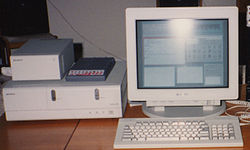Workstation
A workstation is a computer used for scientific or technical calculations, or purposes. These computers are usually expensive, high-end computers. They are different from the ordinary computers used for text-processing. Very often they have operating systems that allow several users to work at the computer at the same time. Very often, workstations are connected to a computer network. Computer terminals may be used to access them. Currently, almost all workstations use a Unix or Unix-like operating system.
Workstation computers often use a 64-bit server-class CPU such as the Intel Xeon or AMD Opteron, and some have more than one CPU. They may also have more memory than a normal desktop computer, and they often have 10000 or 15000 RPM hard drives or solid-state drives. Some workstations have devices that are not commonly used on normal desktop computers, such as ECC (error-corrected) memory, SCSI, fibre channel, and 10 gigabit Ethernet.
Some technologies that were once only found on workstations have now become common in normal PCs, such as multi-core processors, solid-state drives, hardware-accelerated graphics, 24-bit color, broadband Internet access, virtual memory, pre-emptive multitasking, and OpenCL.
Common uses for workstations include computer-aided design (CAD), 3D graphics and animation, video and audio production, weather modeling, and other simulations and scientific work.
RISC vs x86
Traditionally, workstations used a RISC processor, such as MIPS, PowerPC, or SPARC architecture CPUs. Most modern workstations use x86_64 processors. In 2020, however, Apple began migrating its product line from x86-64 to Apple M1, an ARM RISC CPU.
Examples of RISC workstations
- Silicon Graphics IRIX machines (MIPS CPU)
- Sun Microsystems SparcStation (SPARC CPU)
- Apple Power Mac G5 and PowerBook G4 (PowerPC CPU)
- Apple MacBook Pro (2021 model, ARM CPU)
- IBM IntelliStation POWER and ThinkPad Power Series (PowerPC CPU)
Examples of modern x86_64 workstations
- HP Z series
- Apple Mac Pro and MacBook Pro (before 2021)
- Dell Precision
Workstation Media
A NeXTcube workstation, the same type on which the World Wide Web was created by Tim Berners-Lee at CERN in Switzerland
Early Xerox workstation
HP 9000 model 425 workstation running HP-UX 9 and Visual User Environment (VUE)
HP 9000 model 735 running HP-UX and the Common Desktop Environment (CDE)
A NeXTstation graphics workstation from 1990
SGI Indy graphics workstation
SGI O2 graphics workstation










